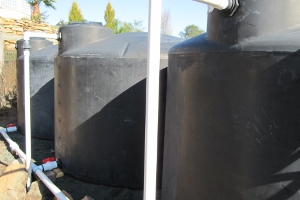 In a backyard in Santa Rosa, three 1550-gallon holding tanks store rainwater.If you're hoping to catch some rain yourself this winter in the Bay Area, you shouldn't have any problems with supply. There's likely to be plenty of water gushing off your roof, since even small ones shed thousands of gallons over the course of a typical rainy season.
In a backyard in Santa Rosa, three 1550-gallon holding tanks store rainwater.If you're hoping to catch some rain yourself this winter in the Bay Area, you shouldn't have any problems with supply. There's likely to be plenty of water gushing off your roof, since even small ones shed thousands of gallons over the course of a typical rainy season.
"A really good rule of thumb is that if you have 1,000-square-foot surface, and you get an inch of rain on it, it will yield about 600 gallons of rainwater," explains Sarah Minick, a storm water planner for the San Francisco Public Utilities Commission. "We get about 20 inches of rain a year in San Francisco. That equals out to about 12,000 gallons for just 1,000 square feet."
In San Francisco, residents can purchase barrels that are already fully assembled at the Urban Farmer store on Vincente at a discount. The first 60-gallon barrel is $89, $30 off the $119 price, and the next barrel is $50 off. Residents can buy up to 10 discounted barrels through the program. In Santa Rosa, the city pays residents and businesses a 25-cent rebate per gallon of rainwater storage with some restrictions.
To really save cash, enterprising do-it-yourselfers make their own barrels. "We know of some people who have systems that have over 20 barrels linked together, and they accomplish that for under $200 by doing it themselves," says Minick.
If you're planning on making your own barrel, don't forget the mosquito netting or screen, and be sure to have a hand saw and a drill handy. The San Francisco Public Utilities Commission offers detailed
instructions, and guidelines for putting together a multi-barrel, daisy chain system.
